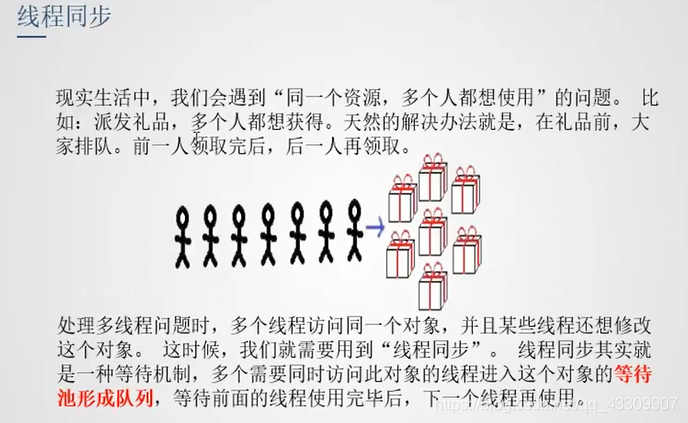多线程
并发
定义:同一个对象多个线程同时操作
线程同步

锁机制(synchronized)
1.synchronized方法
在方法名前加synchronized
public synchronized void test(){
}2.synchronized块
synchronized(obj){
}
死锁
产生:过多的同步造成相互不释放资源,从而相互等待,一般发生于同步中持有多个对象。
解决:不要在一个代码块中持有多个对象的锁就可以了。
并发协作(生产者消费者模式)
1.管程法:
案例:借助容器实现进程间的通信
public class test09 {
public static void main(String[] args) {
SynContainer container=new SynContainer();
new Producter(container).start();
new Customer(container).start();
}
}
//生产者
class Producter extends Thread{
SynContainer container;
public Producter(SynContainer container) {
this.container = container;
}
@Override
public void run() {
for(int i=0;i<100;i++) {
System.out.println("生产--->"+i+"个馒头");
container.push(new Steamedbun(i));
}
}
}
//消费者
class Customer extends Thread{
SynContainer container;
public Customer(SynContainer container) {
this.container = container;
}
@Override
public void run() {
for(int i=0;i<1000;i++) {
System.out.println("消费---》"+container.pop().getId()+"个馒头");
}
}
}
//缓冲区
class SynContainer{
Steamedbun[] buns=new Steamedbun[10];//容器
int count=0;//计数器
//储存
public synchronized void push(Steamedbun bun) {
//判断是否可以生产
if(count==buns.length) {
try {
this.wait();//消费者通知生产
} catch (InterruptedException e) {
// TODO Auto-generated catch block
e.printStackTrace();
}
}
buns[count]=bun;
count++;
this.notifyAll();
}
//获取
public synchronized Steamedbun pop() {
//判断是否能消费
if(count==0) {
try {
this.wait();//线程阻塞,生产者通知解除阻塞
} catch (InterruptedException e) {
// TODO Auto-generated catch block
e.printStackTrace();
}
}
Steamedbun temp=new Steamedbun();
count--;
temp=buns[count];
this.notifyAll();
return temp;
}
}
//馒头
class Steamedbun{
private int id;
public int getId() {
return id;
}
public void setId(int id) {
this.id = id;
}
public Steamedbun() {
}
public Steamedbun(int id) {
this.id=id;
}
}2.信号灯法:
案例:
public class test02 {
public static void main(String[] args) {
Tv tv=new Tv();
new Player(tv).start();
new Watcher(tv).start();
}
}
//生产者-演员
class Player extends Thread{
Tv tv=new Tv();
public Player(Tv tv) {
this.tv = tv;
}
@Override
public void run() {
for(int i=0;i<20;i++) {
this.tv.play("节目"+i);
}
}
}
//消费者-观众
class Watcher extends Thread{
Tv tv=new Tv();
public Watcher(Tv tv) {
this.tv = tv;
}
@Override
public void run() {
for(int i=0;i<20;i++) {
this.tv.watch();
}
}
}
//同一资源-电视
class Tv{
String voice;
//信号灯
boolean flag=true;
//如果为真表示演员表演,观众等待。
//如果为假表示观众观看,演员等待。
public synchronized void play(String voice) {
//判断是否等待
if(!flag) {
try {
this.wait();
} catch (InterruptedException e) {
// TODO Auto-generated catch block
e.printStackTrace();
}
}
System.out.println("表演了"+voice);
this.voice=voice;
//唤醒
this.notifyAll();
//切换标志
this.flag=!this.flag;
}
public synchronized void watch() {
//判断是否等待
if(flag) {
try {
this.wait();
} catch (InterruptedException e) {
// TODO Auto-generated catch block
e.printStackTrace();
}
}
System.out.println("听到了"+voice);
this.notifyAll();
this.flag=!this.flag;
}
}来源:CSDN
作者:persistenthuang
链接:https://blog.csdn.net/qq_43309907/article/details/103955845